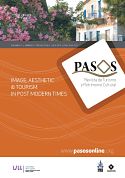The internal structure of destination visitantion model and implications for image management
DOI:
https://doi.org/10.25145/j.pasos.2013.11.037Keywords:
tourist, allocentric, midcentric, psychocentric, Plog, destination marketingAbstract
In the present research, Stanley Plog´s (1967) Psychocentrism - Allocentrism Visitation Model is reimagined. The researcher descomposes Plog´s original model and indentifies five smaller bell shaped curves constituting five tourist within the normal largely prefer nascent destinations, destinations that are close to the end of their life cycles become attractive to them once again.
Downloads
Publication Facts
Reviewer profiles N/A
Author statements
- Academic society
- PASOS. Revista de Turismo y Patrimonio Cultural
- Publisher
- Instituto Universitario de Investigación Social y Turismo. Universidad de La Laguna (España) - Instituto Universitario da Maia ISMAI (Portugal)
References
Abbey, J. 1979 “Does life style profiling work?”. Journal of Travel Research, 18(1): 8-14.
Butler, R. 1980 “The Concept of a Tourist Area Life Cycle: Implications for Management of Resources”. Canadian Geographer, 24: 5-12.
Chon, K.S. & Sparrowe, R.T. 2000 Welcome to Hospitality: An Introduction (2nd edn), Albany: Delmar Thomson Learning.
Crossley, J. C. & Jamieson, L. M. 1999 Introduction to Commercial and Entrepreneurial Recreation. Champaign, IL: Sagamore Publishing.
Fesenmaier, D. R. & Johnson, B. 1989 “Involvement based segmentation: Implications for travel marketing in Texas”. Tourism Management, 10(4): 293-300
George, B.P. 2005 “Measuring tourist attachment to holidays: Some preliminary results”. Tourism: An International Interdisciplinary Journal, 52(3): 229-246.
George, B.P. Inbakaran, R., & Poyyamoli, G. 2010 “To travel or not to travel: Towards understanding the theory of nativistic motivation”. Tourism: An International Interdisciplinary Journal, 58(4): 395-407.
Gramann J. H., Bonifield, R. L., & Kim, Y. 1995 “Effect of personality and situational factors on intentions to obey rules in outdoor recreation areas”. Journal of Leisure Research, 27(4): 326-343.
Gut, A. 2005 Probability: A Graduate Course. New York: Springer-Verlag.
Iwasaki, Y., & Mannell, R. C. 1999 “Situational and personality influences on ntrinsically motivated leisure behavior: Interaction effects and cognitive processes”. Leisure Sciences, 21: 287-306.
Litvin, S. W. 2006 “Revisiting Plog’s model of allocentricity and psychocentricity: One more time”. Cornell Hotel and Restaurant Administration Quarterly, 47(3): 245-253.
Lowyck, E., Van Langenhove, L., & Bollaert, L. 1993 Choice and Demand in Tourism, Johnson, P. and Tomas, B. (Eds). London: Mensell Publishing.
McKercher, B. 2005 “Are Psychographics Predictors of Destination Life Cycles?” Journal of Travel & Tourism Marketing, 19(1): 49-55.
Miguens, J. I. L., & Mendes, J. F. F. 2008 “Travel and tourism: Into a complex network”. Physics and Society, 387(12): 2963-2971.
Park, S., Tussyadiah, I. P., Mazanec, J. A., & Fesenmaier, D. R. 2010 “Travel Personae of American Pleasure Travelers: A Network Analysis”. Journal of Travel & Tourism Marketing, 27(8): 797-811.
Plog, S.C. 1974 “Why destinations areas rise and fall in popularity”. Cornell Hotel and Restaurant Administration Quarterly, November, 13-16.
Plog, S. C. 1990 “A Carpenter’s Tools: An answer to Stephen LJ Smith’s review of psychocentrism/allocentrism”. Journal of Travel Research, 28(4): 43-45.
Plog, S. C.2002 “The power of psychographics and the concept of venturesomeness”. Journal of Travel Research, 40: 244-251.
Pomfret, G. 2006 “Mountaineering adventure tourists: A conceptual framework for research”. Tourism Management, 27: 113-123.
Reisinger, Y., & Mavondo, F. 2005”Travel anxiety and intentions to travel internationally: Implications of travel risk perception”. Journal of Travel Research, 43: 212-225.
Rogers, E. 1964 Diffusion of Innovations. New York: Glencoe Free Press
Smith, S. L. J. 1990 “A Test of Plog’s allocentric/psychocentric model: Evidence from seven nations”. Journal of Travel Research, 28(4): 40-43.
Downloads
Published
How to Cite
Issue
Section
License
I confirm that the work is original (of my/our authorship), and that it will not be submitted to other journals or publications until the final resolution of the review process in PASOS, RTPC.
I authorize the publication of my work by PASOS, PSTN of free and open access in any of the formats that I deem appropriate, for an indefinite period of time and as a non-remunerated collaboration.
Likewise, the author(s) understands that the published work may be linked or deposited on any server or included in other publications (republication), provided that the new place and/or new edition references the original publication and acknowledges the authorship and copyright ownership of PASOS RTPC publications.
Authors understand that a plagiarism-self-plagiarism check will be performed, and the article may be removed at any time from the editorial flow.










